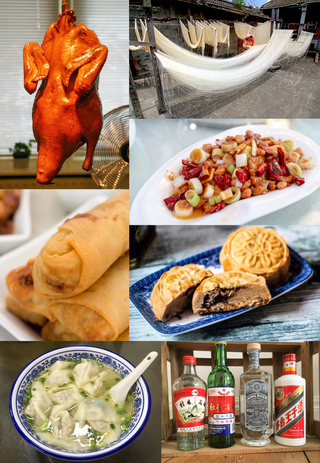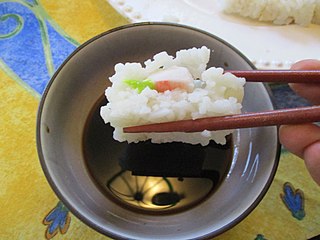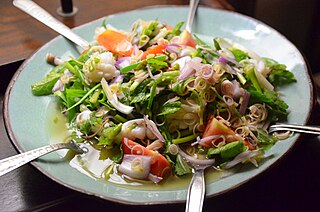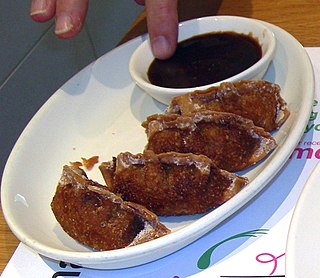
Chinese cuisine comprises cuisines originating from China, as well as from Chinese people from other parts of the world. Because of the Chinese diaspora and historical power of the country, Chinese cuisine has profoundly influenced many other cuisines in Asia and beyond, with modifications made to cater to local palates. Chinese food staples such as rice, soy sauce, noodles, tea, chili oil, and tofu, and utensils such as chopsticks and the wok, can now be found worldwide.
Sweet and sour is a generic term that encompasses many styles of sauce, cuisine, and cooking methods. It is commonly used in East Asia and Southeast Asia and has been used in England since the Middle Ages. Sweet and sour sauce remains popular in Asian and Western cuisines.

Zhajiangmian, commonly translated as "noodles served with fried bean sauce", is a dish of Chinese origin consisting of thick wheat noodles topped with zhajiang, a fermented soybean-based sauce. Variations may include toppings of fresh or pickled vegetables, beans, meat, tofu, or egg. In the Western press, it is occasionally dubbed "Beijing bolognaise" due to its superficial similarity and ubiquitous nature.

A dip or dip sauce is a common condiment for many types of food. Dips are used to add flavor or texture to a food, such as pita bread, dumplings, crackers, chopped raw vegetables, fruits, seafood, cubed pieces of meat and cheese, potato chips, tortilla chips, falafel, and sometimes even whole sandwiches in the case of jus. Unlike other sauces, instead of applying the sauce to the food, the food is typically placed or dipped into the sauce.

Filipino cuisine is composed of the cuisines of more than a hundred distinct ethnolinguistic groups found throughout the Philippine archipelago. A majority of mainstream Filipino dishes that compose Filipino cuisine are from the food traditions of various ethnolinguistic groups and tribes of the archipelago, including the Ilocano, Pangasinan, Kapampangan, Tagalog, Bicolano, Visayan, Chavacano, and Maranao ethnolinguistic groups. The dishes associated with these groups evolved over the centuries from a largely indigenous base shared with maritime Southeast Asia with varied influences from Chinese, Spanish, and American cuisines, in line with the major waves of influence that had enriched the cultures of the archipelago, and adapted using indigenous ingredients to meet local preferences.

Duck sauce is a condiment with a sweet and sour flavor and a translucent orange appearance similar to a thin jelly. Offered at American Chinese restaurants, it is used as a dip for deep-fried dishes such as wonton strips, spring rolls, egg rolls, duck, chicken, fish, or with rice or noodles. It is often provided in single-serving packets along with soy sauce, mustard, hot sauce or red chili powder. It may be used as a glaze on foods, such as poultry. Despite its name, the sauce is not prepared using duck meat; rather it is named as such because it is a common accompaniment to Chinese-style duck dishes.

The generic term for condiments in the Filipino cuisine is sawsawan. Unlike sauces in other Southeast Asian regions, most sawsawan are not prepared beforehand, but are assembled on the table according to the preferences of the diner.

Chili sauce and chili paste are condiments prepared with chili peppers.

Pakistani Chinese cuisine comprises the styles and variations of Chinese cuisine that are cooked and consumed in Pakistan. Chinese migrants to Pakistan have developed a distinct Pakistani-style Chinese cuisine.

Sundanese cuisine is the cuisine of the Sundanese people of Western Java, and Banten, Indonesia. It is one of the most popular foods in Indonesia. Sundanese food is characterised by its freshness; the famous lalab eaten with sambal and also karedok demonstrate the Sundanese fondness for fresh raw vegetables. Unlike the rich and spicy taste, infused with coconut milk and curry of Minangkabau cuisine, the Sundanese cuisine displays the simple and clear taste; ranged from savoury salty, fresh sourness, mild sweetness, to hot and spicy.

Nam chim or nam jim is Thai for "dipping sauce". It can refer to a wide variety of dipping sauces in Thai cuisine, with many of them a combination of salty, sweet, spicy and sour.

Salads that are internationally known as Thai salads with a few exceptions fall into four main preparation methods. In Thai cuisine these are called yam, tam, lap and phla. A few other dishes can also be regarded as being a salad.

Crab Rangoon, sometimes called crab puffs, crab rangoon puffs, cheese wontons, or cream cheese rangoons, are filled crisp dumpling appetizers served primarily in American Chinese restaurants.

Hoisin sauce is a thick, fragrant sauce commonly used in Cantonese cuisine as a glaze for meat, an addition to stir fry, or as dipping sauce. It is dark-coloured, sweet and salty. Although regional variants exist, hoisin sauce usually includes soybeans, fennel, red chili peppers, and garlic. Vinegar, five-spice powder, and sugar are also commonly added.

Rujak or rojak is a salad dish of Javanese origin, commonly found in Indonesia, Malaysia and Singapore. The most popular variant in all three countries is a salad composed of a mixture of sliced fruit and vegetables served with a spicy palm sugar dressing. It is often described as tangy and spicy fruit salad due to its sweet, hot and spicy dressing made from ground chilli, palm sugar and peanuts.















